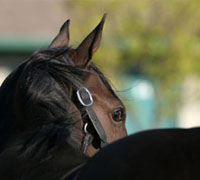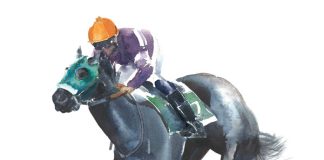 If you need an excuse to pay for quality riding instruction, consider it an investment in your horse’s health and comfort.
If you need an excuse to pay for quality riding instruction, consider it an investment in your horse’s health and comfort.
The researchers observed 19 lesson horses from two different riding schools. The horses varied in age and breed. The horses were observed during lessons with beginner riders–in this case riders who had received less than 50 total hours of saddle time–where common rider errors were more likely to occur.
Because back problems in the horse may exist without causing any apparent symptoms, researchers needed an expert to examine the horses for physiological spinal issues. Initial examination of the horses in the study was conducted by a licensed chiropractor with a separate examination done by another chiropractor to ensure accuracy. 74% of the horses were found to be severely affected by vertebral problems with 60% being affected in more than one area of the spine. Only one horse was found to be completely free of back issues.
The researchers observed still images taken from video footage of beginners’ riding lessons and collected data on various elements of horse and rider position.
For the horses, researchers documented neck height (high, low, or horizontal) and neck shape (round, flat, or hollow.)
For riders, the researchers observed the height of their hands, the height of their heels (by angle of the ankle) and the length at which they held their reins.
The research demonstrated several connections between the horses’ position and back issues.
- Horses with a high neck position were more likely to also have a hollow neck.
- Horses that were observed more frequently in a high neck position had more vertebral problem spots.
- Horses that were unaffected or only slightly affected by vertebral problems were never observed in a high neck position, and were more frequently observed in a low neck position than the horses that were severely affected.
Additionally, researchers found clear correlations between rider position and horse neck carriage.
- Riders who rode with their hands in the low position were more likely to have a horse with a round neck position.
- Horses whose riders kept their rein length long (in this case, defined as rein length longer than the horse’s neck) were less likely to display a high and/or hollow neck position.
- Medium length reins (between 50% to 100% of the horse’s neck length) correlated with increased incidence of high neck position.
- Riders observed with a low heel position had mounts that were more frequently observed with a low neck position.
Researchers noted a marked difference between horses and riders in the two schools they observed.
| School A | School B |
| 100% of horses observed were severely affected by vertebral problems | 50% of horses were severely affected. |
| More horses were observed with a high and/or hollow neck position | Horses were most often observed with a horizontal or low neck position and round neck shape. |
| More students were observed with high hands, high heels, and short reins. | Students were more likely to display low heels, low hands, and long reins. |
| 80% of instruction given related to riders’ form. | 99% of instruction given related to riders’ form. |
| Riders were told to shorten their reins more than twice as often as they were told to lengthen them | Riders were frequently told to lower their hands, move their hands forward, or lengthen their reins. They were seldom told to shorten their reins. |
The researchers observed that a rider’s position does affect a horse’s position. Weak position in a rider, which is demonstrated as high hands and/or high heels, appears to cause a weak position in the horse, specifically a high and/or hollow neck which has been shown to correlate with more severe and more frequent back problems. Furthermore, with relatively inexperienced riders, the type of instruction they receive appears to have a strong influence on their riding, which subsequently affects the school horses’ soundness. In this case, a teacher whose instructions were almost exclusively related to rider form had a sounder string of lesson horses than an instructor who devoted less time to proper equitation.
For more information, read the full research report >>
Lesimple, C., Fureix, C., Menguy, H., Hausberger, M. (2010)
Human direct actions may alter animal welfare, a study on horses (Equus caballus). PLoS ONE 5(4): e10257. doi:10.1371/journal.pone.0010257






Great information
Good info for a beginner.
It causes problems in the backs of riders too.
Too bad not all instructors are qualified to instruct. Maybe not as many horses would end up in my barn with mouth and back issues.
It’s great for young horse ridders to read this article. It teaches you alot about looking great for a show. My sister used to look like a sack of potatoes when she was in a show once. I told her it was very bad for her back. Know I can tell her about this article that can help her posture!!
Well about time this is being brought to attention..Jean Luc Cornille has been teaching and trying to educate the equestrian world for almost 30 years! scienceofmotion.com He travels giving clinics and lectures on this. TO learn more about him and his works and studies visit scienceofmotion.com